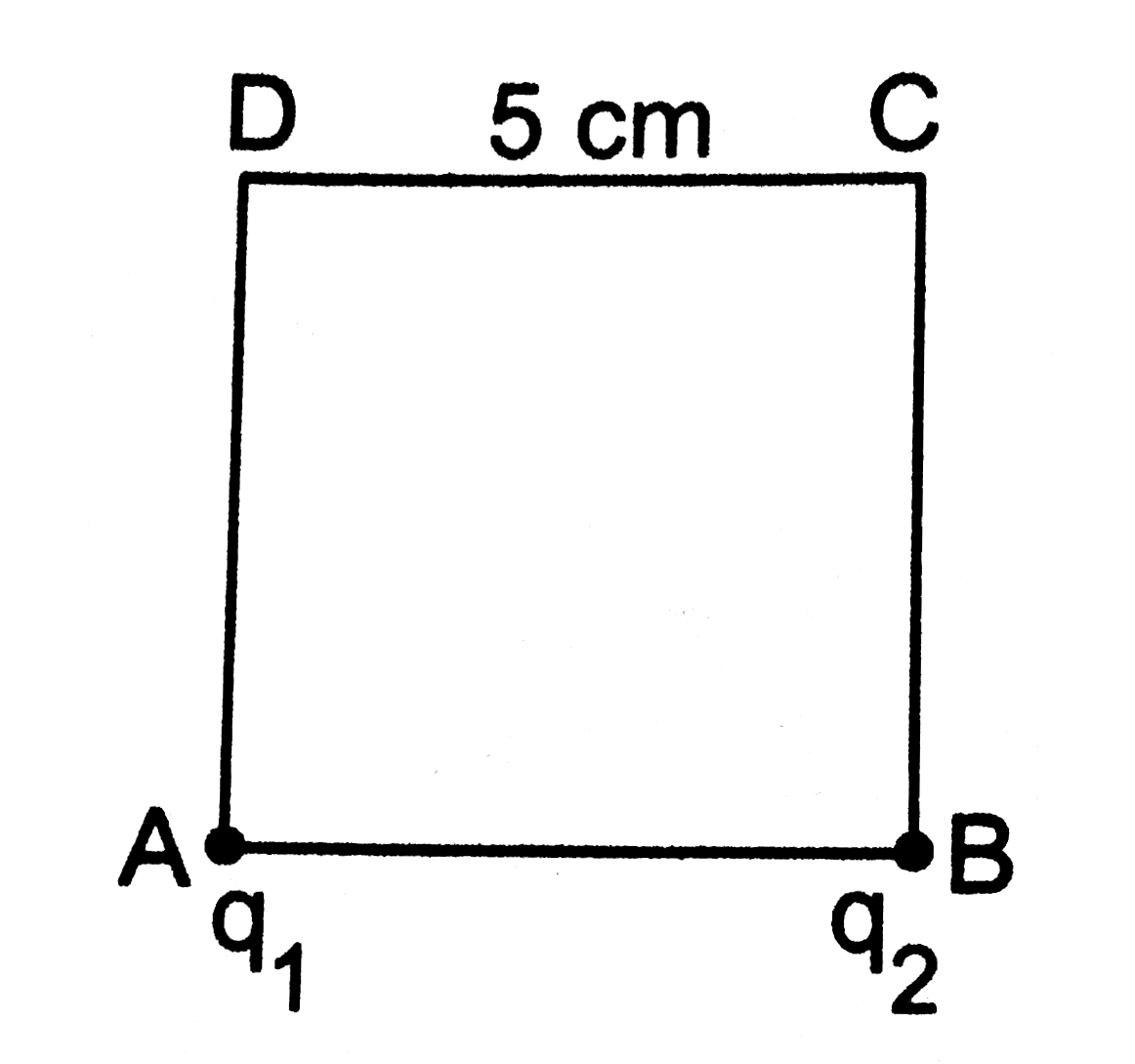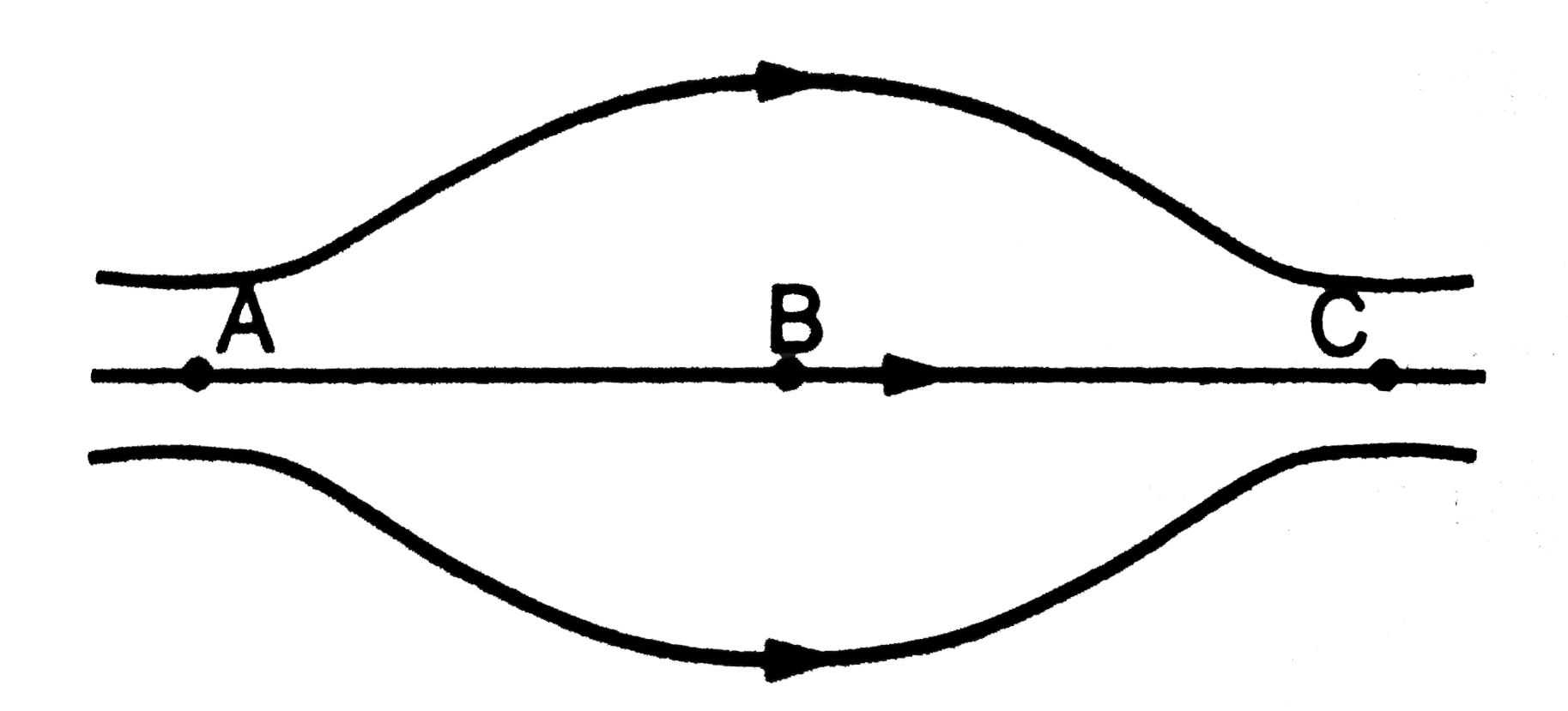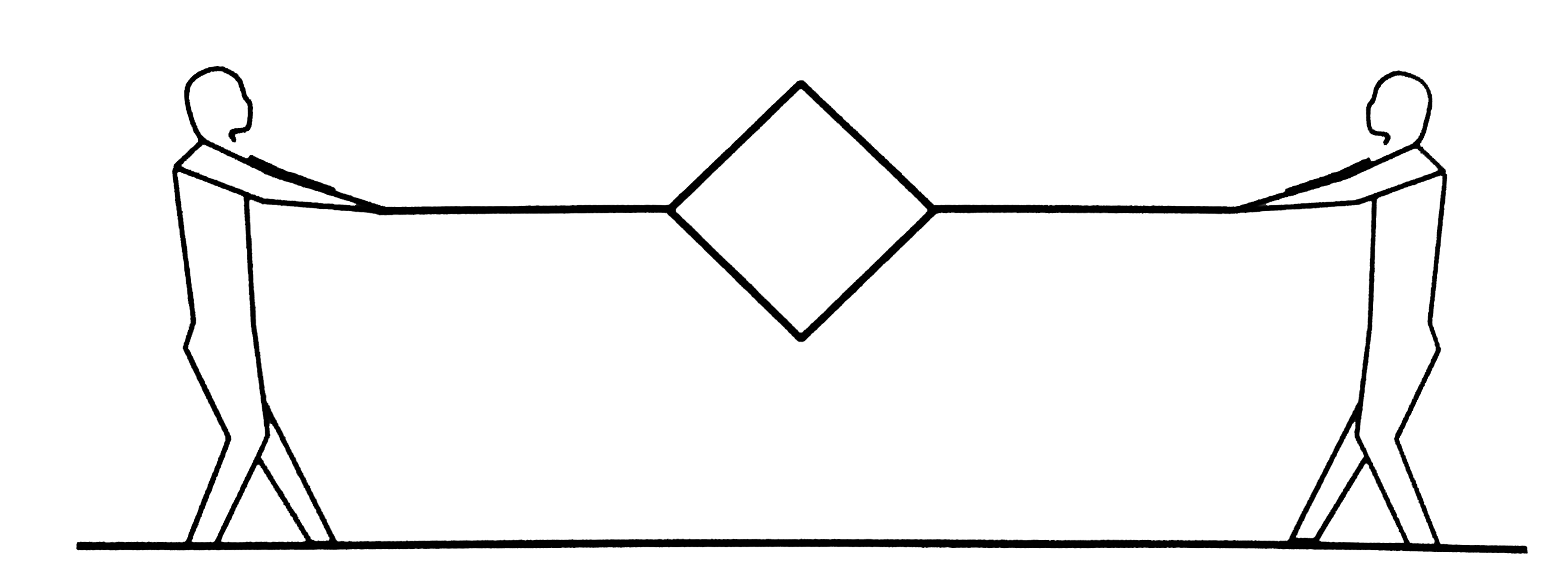charges 2.0×10−6C and 1.0×10−6C are placed at. corners A and B of a squae of side 5.0cm as shown in. figure .how much work will be done against. the electric field in moving a charge of 1.0 xx 10^(-6) C from. C to D?.
 Solution in Gujrati
Solution in Gujrati
The electric potential at C
=14πε0(q1AC+q2BC)
=9×109Nm−2C(−2)⎛⎜⎝2.0×10(−6)C√2×0.05m+1.0×10(−6)C0.05m
=(9000V)(2+√2√2×0.05)
. The electric potential at D
=14πε0(q1AD+q2BD
=9×109Nm−2C(−2)(2.0×10(−6)C0.05m+1.0×10(−6)C√2×0.05m)
=(9000V)(2√2+1√2×0.05)<br>.Theworkdo≠aga∈stthee≤ctricfield∈mov∈gthe<br>char≥1.0xx 10(-6)CimC→disq(V_D- V_C)<br>= (1.0xx 10(-6) C)(900V) ((2sqrt2+1-2-sqrt2)/(sqrt2 xx o.05))
=0.053J
Topper's Solved these Questions
- BOOK - HC VERMACHAPTER - ELECTRIC FIELD AND POTENTIALEXERCISE - Short Answer14videos
ELECTRIC FIELD AND POTENTIAL
- BOOK - HC VERMACHAPTER - ELECTRIC FIELD AND POTENTIALEXERCISE - Objective 19videos
ELECTRIC FIELD AND POTENTIAL
- BOOK - HC VERMACHAPTER - ELECTRIC FIELD AND POTENTIALEXERCISE - Exercises75videos
ELECTRIC FIELD AND POTENTIAL
- BOOK - HC VERMACHAPTER - ELECTRIC CURRENT THROUGH GASESEXERCISE - Exercises23videos
ELECTRIC CURRENT THROUGH GASES
- BOOK - HC VERMACHAPTER - ELECTROMAGNETIC INDUCTIONEXERCISE - EXERCISE9videos
ELECTROMAGNETIC INDUCTION
Similar Questions
The charge on a proton is +1.6X10(−19)C and that on an electron is −1.6X10(−19)C. Does it mean that the electron has a charge 3.2X10(−19)C less than the charge of a proton?
05:18View SolutionFigure shows some of the electric field lines correspoinding to an electric field. The figure suggests that
 05:43View Solution
05:43View SolutionFind the dimensional formula of ε0 .
02:34View SolutionA discharge tube contains helium at a low pressure. A large potential difference is applied across the tube. Consider a helium atom that has just been ionized due to the detachment of an atomic electron. Find the ratio of the distance travelled by the free electron to that by the positive ion in a short time dt after the ionization.
04:10View SolutionShown a metallic square frame of edga a in a vertical plane. A uniform magnetic field B exists in the space in a directon perpendicular to the plane of the figure. Two boys pull the opposite corners of the square ot deform it into a rhombus. They start pulling the corners t t=0 and sisplace the corners at a uniform speed u. (a) find the induced emf in the frame at the instant when the angles at these corners reduce to 60∘. (b) find the induced current in the frame at this instatnt if the total resistance of the frame is R. (c) Find the total charge which flows through a side of the frame by the time the square is deformed into a straight line.
 04:10View Solution
04:10View Solutioncharges 2.0×10−6C and 1.0×10−6C are placed at. corners A and B of a squae of side 5.0cm as shown in. figure .how much work will be done against. the electric field in moving a charge of 1.0 xx 10^(-6) C from. C to D?.
 07:47View Solution
07:47View SolutionSuppose the second charge in the previous problem is −1.0×10−6C. Locate the position where a third charge will not experience a net force.
02:20View SolutionThree charges q_1 = 1 xx 10^(-6) C, q^2 = 2 xx 10^(-6)C, and q_3 = -3 xx 10^(-6) C have been placed as shown in figure. Then the net electric flux will be maximum for the surface
02:15View SolutionThree charges q_(1), q_(2) and q_(3) are shown in figure . Determine the net force acting on charge q_(1) . The charges and separation are given as q_(1) =- 1.0 xx 10^(-6)C, q_(2) =+ 3.0 xx 10^(-6)C , and q_(3) = - 2.0 xx 10^(-6)C, r_(12) = 15 cm, r_(13) = 10 cm and theta = 30^(@) .
06:59View Solutionएक वैधुत द्विध्रुव 1.0×10−6 कूलॉम परिणाम तथा विपरीत प्रकृति के दो विधुत आवेशों से बना है । इन आवेशों के बीच की दुरी 2.0 सेमी है । इस द्विध्रुव को 1.0×105 न्यूटन/कूलॉम की बाह्य विधुत - क्षेत्र तीव्रता में रखा गया है । द्विध्रुव पर अधिकतम बल - आघूर्ण का मान निकालिए ।
07:42View SolutionAt the three vertices of an equilateral triangle of side 10 cm, +1.0 xx 10^(-7)C, +2.0 xx 10^(-7)C and -4.0 xx 10^(-7)C charges are placed. Calculated the potential energy of the system of these charges.
05:39View Solutionएक विद्युत द्विध्रुव में +1.0×10−6C तथा −1×10−6C के दो बिन्दु आवेश एक-दूसरे से 2 cm की दूरी पर स्थित है। यह विद्युत द्विधुव 1.0×105 V/m के समरूप विद्युत क्षेत्र में स्थित है। ज्ञात करो-
द्विध्रुव पर विद्युत क्षेत्र द्वारा लगने वाला अधिकतम बलाघूर्ण |View Solutionएक विद्युत द्विध्रुव में +1.0×10−6C तथा −1×10−6C के दो बिन्दु आवेश एक-दूसरे से 2 cm की दूरी पर स्थित है। यह विद्युत द्विधुव 1.0×105 V/m के समरूप विद्युत क्षेत्र में स्थित है। ज्ञात करो-
द्विध्रुव पर स्थायी सन्तुलन की स्थिति में स्थितिज ऊर्जा |03:28View SolutionCharges 5.0×10−7C,−2.5×10−7Cand1.0×10−7C are
held fixed at the three corners A, B, C of equilateral triangle of side 10cm respectively. Find the electric force on the charge at C due to the rest two.02:49View Solutioncharges 2.0×10−6C and 1.0×10−6C are placed at. corners A and B of a squae of side 5.0cm as shown in. figure .how much work will be done against. the electric field in moving a charge of 1.0 xx 10^(-6) C from. C to D?.
 02:38View Solution
02:38View SolutionSuppose the second charge in the previous problem is −1.0×10−6C. Locate the position where a third charge will not experience a net force.
View Solution

